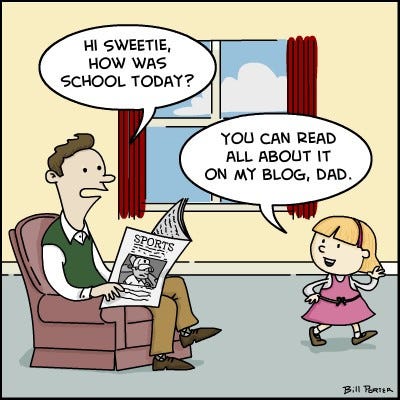The student-centred organization and teaching process to help students complete the future-oriented ability and competitiveness training is an inevitable choice in the media era. The future success of students is the fundamental guarantee for the vitality of a school. Current students have grown up in the environment of computers and the Internet, and have been accustomed to various technology applications since childhood, so they are also called “digital natives”. Compared with the “digital immigrant” generation, the behavior patterns and learning styles of this generation of students have had an impact on education. For example, students cannot do without electronic devices, do not pay attention to the lecture, search for answers on the Internet, use AI to complete homework and prefer fragmented electronic reading. In order to get students to come back to class and listen carefully, teachers use a variety of methods, such as in-class testing, taking photos of attendance, and confiscating mobile phones before class. These interesting new phenomena fully reveal the contradiction between the new learning behavior mode and the traditional classroom teaching mode.

Learning behavior patterns have changed
Students in the Internet era are accustomed to receiving information quickly, are good at multitasking, prefer instant affirmation and frequent rewards, prefer the “game” mode rather than the “serious” mode, rely on the connectivity of the network, prefer to use information technology according to their own habits and preferences, like rapid real-time feedback, and tend to text-based communication. However, they are not capable of face-to-face communication, and entertainment technology and game tools surround them all the time. And these new behavior patterns have brought considerable trouble to traditional teachers and teaching patterns. The traditional classroom model takes the teacher as the center and basically transmits knowledge one way through the form of classroom teaching. Because teachers and textbooks monopolize knowledge, it is difficult for students to obtain knowledge from other channels, so classroom teaching is the main form of teaching and learning. In the Internet era, no matter in content or form, knowledge can be obtained anytime and anywhere on the Internet, which breaks the irreplaceability of teachers and classroom teaching. The management and assessment process for students is also more difficult because students can easily search for answers on the Internet or share them with their classmates online. Therefore, both learning theory and teaching practice need to change with the change in current students’ cognitive behavior patterns.

Learning theory in the media age
When computer network technology develops rapidly and changes the whole world completely, education is developing towards information, socialization and networks. Learning, as the fundamental means to adapt to the changes of The Times, has also undergone significant changes. Any student concerned about their own survival and development, any teacher concerned about student learning effectiveness, but pay attention to the evolution and change of learning ability in the Internet age, and the potential impact of this cognitive change. The new learning theory provides the theoretical basis and points out the direction for teaching and learning in the media age.
The development of information technology has revolutionized the way of learning, life and communication. Informal learning has gradually become the mainstream of learning, and “technology support” has become the main feature of information learning. Everyone is the creator, transmitter, receiver, possessor and terminator of knowledge. Information flows among different individuals in the form of “information flow” using media such as networks, thus forming a variety of knowledge networks. Therefore, learning is a continuous process of building a knowledge network. The establishment of a knowledge network is the premise and foundation of keeping knowledge epochal, sustainable and innovative.

Redefine teaching and learning
The concept of learning in the media age emphasizes the initiative of construction. The learner is first of all a subject. As the initiator of learning activities, the learner has undoubted initiative. Knowledge is not acquired through teachers’ teaching but through students’ self-construction of knowledge, active information absorption, processing and integration of new information based on original cognition.
In the learning process, the relationship between teachers and students is equal, and the role of teachers will be transformed into learning organizers and managers of students, and even learning partners. Teaching is no longer a one-way transfer of knowledge between teachers and students because the completion of learning depends on the individual’s own active construction. As the basis of learning or construction, the original experience and knowledge structure of an individual constitutes the starting point of learning.

The technology-driven changes in the media era are both challenges and opportunities. The student-centred organization and teaching process to help students complete the future-oriented ability and competitiveness training is an inevitable choice in the media era. The future success of students is the fundamental guarantee for the vitality of a school.
6 Comments
Matthew
Hi Echo, thank you for your sharing your thoughts. While I agree that student communication patterns are evolving and changing I wouldn’t go so far as to say that they are not capable of face to face communication. As one of our articles pointed out online and real world interactions co-exist symbiotically (rather than to the exclusion of one another). Interpersonal social skills “in the real world” may be waning, but they still form a significant portion of our interactions. As surreal as it sounds there may come a time when we have to explicitly teach students face-to-face interaction skills (heck, we might even be at that point now).
Further to your point of traditional classroom models being challenged I partially agree. It does become difficult to break out of a rut, but I don’t think any classroom is 100% traditional, or for that matter 100% on the bleeding edge of technology. I feel it is more of a continuum with teachers falling somewhere along it. I agree that we will do far more facilitation in the future as the emphasis on rote knowledge declines, but I think that instructors will still do a great deal of direct instruction in the use of new tools.
Echo
Hi Matthew,
You’re right; classrooms exist along a continuum, with some teachers embracing technology more readily than others. Striking a balance between traditional and tech-enhanced teaching methods is often the key to effective instruction. As you mentioned, direct instruction on the use of new tools is crucial, especially as technology continues to play a greater role in education.
Curtis Norman
Hi Echo, I would love it if I could read my son or daughters blog everyday about their adventures in school yet sometimes I barely find time to sign their agenda 🙁 I remember about 7 years ago when I was teaching a grade 8 Math class to 38 students I flipped my Math class as a way to adapt to the class size and complexity. As I was reading your blog I kept thinking of a scene from the movie Moneyball with Brad Pitt. The movie is based on real life events of Billy Beane a GM for the Oakland Athletics baseball team and he is thinking outside the box on how to compete with teams that have a higher bankroll than his team. Billy was receiving a lot of criticism for the new way of thinking he brought to the GM role and at one point in the movie a friend says to him, “the first one through the wall always gets bloody…” simply meaning if you are first with an idea (ie. chatGPT in the classroom) you are going to get criticism but 15 years from now it will be commonplace.
Sometimes I feel like as educators we are being the first generation of teachers to break through that wall and we sometimes take bumps and bruises along the way tp pave the ground for future educators.
Echo
Hi Curtis,
I appreciate your sentiment and the analogy to “Moneyball” is quite fitting. It’s true that innovation in education, such as integrating technology like ChatGPT into the classroom, can often face resistance and skepticism, just as Billy Beane did when revolutionizing baseball management.
Graeme Gieni
Great post Echo! I couldn’t agree more with students not being able to deal with face to face communication or real life conversations. They can have disagreements at school but don’t deal with it here, they wait to get home to Snapchat and text their issues. I deal primarily with Grade 5 and 6 students, and they think they know how to properly use websites and find information, but they are so far off. If it is not instant feedback, they don’t know how to pursue answers from different angles.
Echo
Hi Graeme,
Your observations about students’ challenges with face-to-face communication and their digital reliance are spot on, especially among the Grade 5 and 6 age group. It’s a reflection of the evolving communication landscape in the digital age. While students might appear proficient in using technology, there’s a distinction between being tech-savvy and digitally literate. Digital literacy encompasses the ability to critically evaluate online information, search effectively, and discern credible sources. These are skills that can and should be taught in schools.